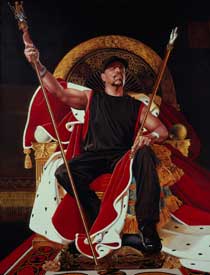The Smithsonian's National Portrait Gallery has taken a bold step into the 21st century with the exhibition Recognize: Hip Hop and Contemporary Portraiture, on view through October 26. Six visual artists and one poet were invited to present their interpretations of hip hop's legacy through the medium of portraiture, characterized as the representation of recognizable figures, in media including photography, video, painting, installation and graffiti.
Kehinde Wiley, Ice T, 2005
Kehinde Wiley is a contemporary portraitist using traditional techniques and imagery to create canonical images of present-day black men, some celebrities and others regular folks. Wiley has a keen grasp of the history of Western painting, and his pictures contain layers of commentary on race, power, masculinity and self-image. By turns, Wiley samples precedents from the Dutch Old Masters, Italian Renaissance, Rococo, Pre-Raphaelites and even Socialist Realists. Unsurprisingly, his work has drawn both praise and criticism for replacing white kings, saints and Christ himself with young urban black men. At the National Portrait Gallery, the paintings feature hip hop pioneers such as Ice T, LL Cool J, Big Daddy Kane and Grandmaster Flash and the Furious Five, each of whose portrait is derived from one of a historical figure with whom the contemporary subject identifies. Wiley's work is also on view at the Studio Museum of Harlem through October 26.
Jefferson Pinder, Mule, 2006
Jefferson Pinder creates performances out of long-held stereotypes regarding the African-American experience. These are exhibited as videos in which the artist performs loaded actions that exaggerate and question our assumptions about the place and value of black people in American society. In Mule, Pinder drags a heavy load through a desolate urban landscape. He plays the part of an enslaved man, shackled to the past and to poverty, but his suit and sunglasses connote a conflicting image of upward mobility. Pinder's films are often accompanied by energizing music of his own composition, which enhance their emotional resonance and rhythmically punctuate the action. Pinder's work is also included in the exhibition After 1968: Contemporary Artists and the Civil Rights Legacy at the High Museum in Atlanta, GA, a major exhibition featuring seven young black artists whose projects respond to the history of civil rights in America.
Shinique Smith, No Thief to Blame, 2007-08
Shinique Smith, whose sculpture at Yvon Lambert in New York I covered earlier this week, has created a site-specific installation at the National Portrait Gallery as a response to poet Nikki Giovanni's commissioned poem for the exhibition, It’s Not a Just Situation: Though We Just Can’t Keep Crying About It (For the Hip Hop Nation That Brings Us Such Exciting Art). Giovanni is a hugely influential poet and a major contributor to the civil rights movement, and her writing has had an enormous impact on women of color in the United States. Smith's installation weaves together her signature calligraphic line with collage elements including images of hip hop's dearly departed -- tragic figures such as Tupac Shakur, Biggie Smalls, Lisa "Left Eye" Lopez and Easy-E whose deaths too young represent the darker side of the lifestyle celebrated in the exhibition. Smith informs her references to black urban culture with a deep current of Eastern philosophy. In this work, she may suggest that the suffering of her community could be alleviated by a lessened emphasis on self-inflicted injury in the name of authentically representing an oppressive past.The National Portrait Gallery's 2007 renovation presented an opportunity for the NPG and its sister institution, the Smithsonian American Art Museum, to rethink how they present their historic collections of art objects to reflect the cultural values of today. They wisely chose not to preserve a monolithic view of American history, but also have avoided the politically-correct strategy of eliminating the more onerous figures within their galleries. Instead, the NPG presents a multifaceted view of American history in which portraits of famous slaveowners hang beside those of ex-slaves, and Native American and Latino heroes are presented alongside generals. The point is to engender a dialogue about the past which our country desperately needs. For this alone, it's worth a visit, but if you can get there before Recognize ends, you will really be in luck.





No comments:
Post a Comment